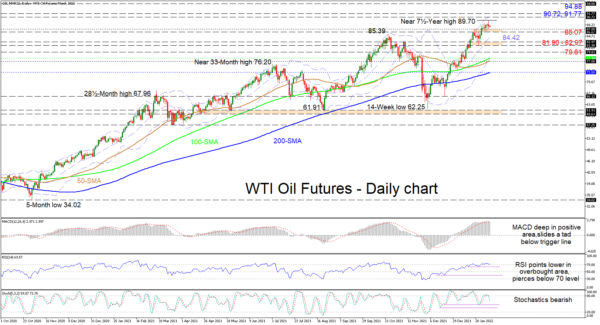WTI oil futures’ 10-week rally from 66.12 has recorded a near 7½-year high of 89.70 but the price has detached from the upper Bollinger band, hinting that bullish momentum has slowed to some extent. The commodity seems to be running on fumes lately, but the rising simple moving averages (SMAs) continue to endorse the bigger positive structure in the pair.
The short-term oscillator’s bullish demeanour is reflecting the recent minor loss of positive impetus in the commodity but have yet to confirm that negative pressures have gained the upper hand. The MACD, quite a distance north of the zero mark, is trailing marginally beneath its flattened red trigger line, while the RSI has slipped out of overbought territory. Moreover, the now bearish tone of the stochastic oscillator is promoting downward price moves.
If the positive drive of the commodity continues to wane, an initial band of support from the 87.00 handle until the 86.07 level could try to provide the black liquid with fresh upside traction. However, if the price fades further, the next upside defence could occur at the mid-Bollinger band at 84.42 prior to the 81.90-82.97 support barrier. Should an uninterrupted price correction unfold, the precious commodity could then test the 79.81 obstacle before eyeing the lower Bollinger band.
On the other hand, if upside impetus is jump started around the 86.07-87.00 boundary, resistance could commence at the more than 7-year high of 89.70 before the bulls challenge the fortified zone of resistance between the 90.72 and 91.77 highs, identified in October 2014. Successfully steering beyond this reinforced border would rejuvenate the broader uptrend, propelling the price towards the 94.88 hurdle.
Summarizing, WTI futures are sustaining a bullish bias despite the minor withdrawal in the price. That said, a retracement in the commodity below the 81.90-82.97 support could feed negative tendencies, while a climb beyond the 90.72-91.77 section may boost the rally.













